Keep counting: the Bible's tales of resurrection go beyond Lazarus and Jesus, each with profound meanings waiting to be discovered.
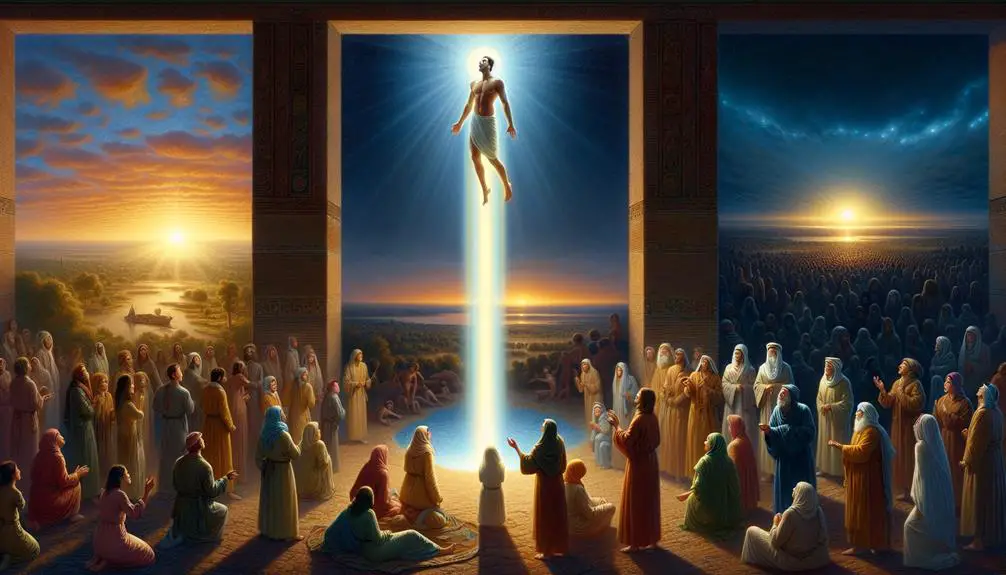
How Many Resurrections Are There in the Bible
In the realm of the living and the dead, the Bible blurs lines with tales of resurrection that both astonish and confound. You've likely heard of Lazarus' miraculous return from the grave or Jesus' own triumph over death, but these are just the beginning.
From the widow's son to Tabitha's revival, each story invites you to explore deeper mysteries and meanings. Why do these resurrections occur, and what do they symbolize for believers and skeptics alike?
Let's embark on a journey to uncover the significance behind these divine interventions, and perhaps, in the process, find more than just answers.
Key Takeaways
- The Bible recounts several significant resurrections, including those performed by Elijah, Jesus, and involving Lazarus.
- These miraculous events underscore the divine authority and power over life and death.
- Witnesses' reactions to these resurrections range from astonishment to skepticism, highlighting varying interpretations and impacts on faith.
- Resurrections serve as profound theological symbols, reinforcing hope and the promise of life beyond death for believers.
The Widow's Son

In the biblical account, the resurrection of the widow's son by the prophet Elijah stands as a seminal example of divine intervention in human mortality. This particular narrative, deeply embedded within the fabric of Judeo-Christian tradition, showcases not just a miraculous act but serves as an emblem of Elijah's faith and its profound social consequences.
Elijah's faith, as depicted in this story, isn't merely a personal conviction but a dynamic force that bridges the human with the divine. His unwavering belief in God's power not only facilitates the miraculous resurrection but also reinforces the role of prophets as intermediaries between the divine will and the earthly realm. This act of faith doesn't just revive a child; it reinvigorates the spiritual vitality of the community, affirming the presence and intervention of God in their lives.
The social consequences stemming from this resurrection are multifaceted. Firstly, it significantly alters the widow's social status and economic survival. In a society where widowhood could marginalize women to the fringes of society, the revival of her only son ensures her social and financial security. Furthermore, this event serves to solidify Elijah's position and credibility as a prophet among the people, enhancing the communal faith in prophetic messages and divine providence.
Analyzing this narrative through a scholarly lens reveals that the resurrection of the widow's son by Elijah isn't just an isolated miracle but a pivotal event with deep theological implications and social ramifications. It underscores the power of faith to invoke divine intervention and highlights the integral role of such interventions in shaping community dynamics and beliefs.
Jairus' Daughter
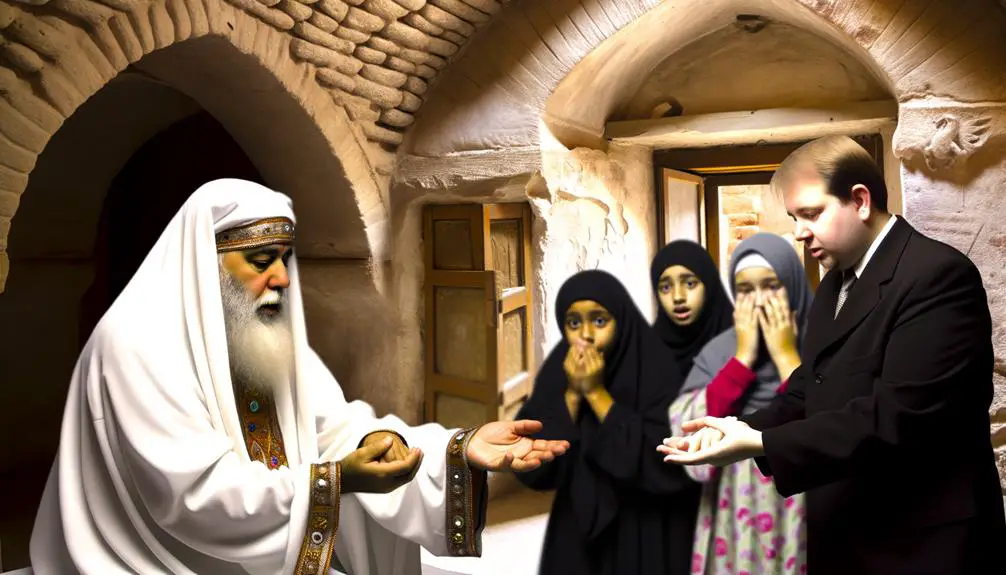
You'll find that the account of Jairus' daughter's resurrection not only showcases a miraculous revival but also captures the astonished reactions of the witnesses in vivid detail.
This narrative, embedded within the synoptic Gospels, offers a rich tapestry for understanding the dynamics of faith, skepticism, and divine intervention. Analyzing these elements sheds light on the broader thematic concerns of life, death, and the power of belief in the New Testament.
Miraculous Revival Details
Analyzing the New Testament account, one finds that Jairus' daughter's resurrection stands as a cornerstone example of Jesus' miraculous power to revive the dead. This event not only showcases His divine authority but also triggers resurrection skepticism and varied cultural interpretations. The skepticism often stems from questioning the veracity of miraculous events, while cultural interpretations range from literal acceptance to symbolic understanding of resurrection as a motif for spiritual awakening.
Aspect |
Detail |
Significance |
|---|---|---|
Context |
Jairus pleads for his dying daughter |
Demonstrates faith and desperation |
Action |
Jesus commands, "Talitha koum" |
Highlights Jesus' authority over life and death |
Outcome |
The girl rises and walks |
Serves as a testament to Jesus' power |
This account vividly illustrates the profound impact of Jesus' miracles on His followers and detractors alike, inviting deep reflection on the nature of faith, the possibility of miracles, and the meanings they hold across cultures.
Witnesses' Astonished Reactions
The astonishing reactions of those who witnessed the revival of Jairus' daughter underscore the profound and immediate impact of Jesus' miraculous act on both believers and skeptics. This scene illuminates the emotional impact and cultural implications of such an event in a context deeply entrenched in both religious expectations and skepticism towards the supernatural.
Witnesses' astonishment wasn't merely a reaction to the unexpected; it was a complex mix of reverence, fear, and joy that challenged prevailing norms and beliefs. The emotional resonance of this moment transcends simple amazement, touching on the core of human desires for life beyond death, while also confronting the cultural boundaries that define what's considered possible or divine.
This reaction embodies a pivotal moment of transformation in the collective understanding of Jesus' power and mission.
Lazarus' Return
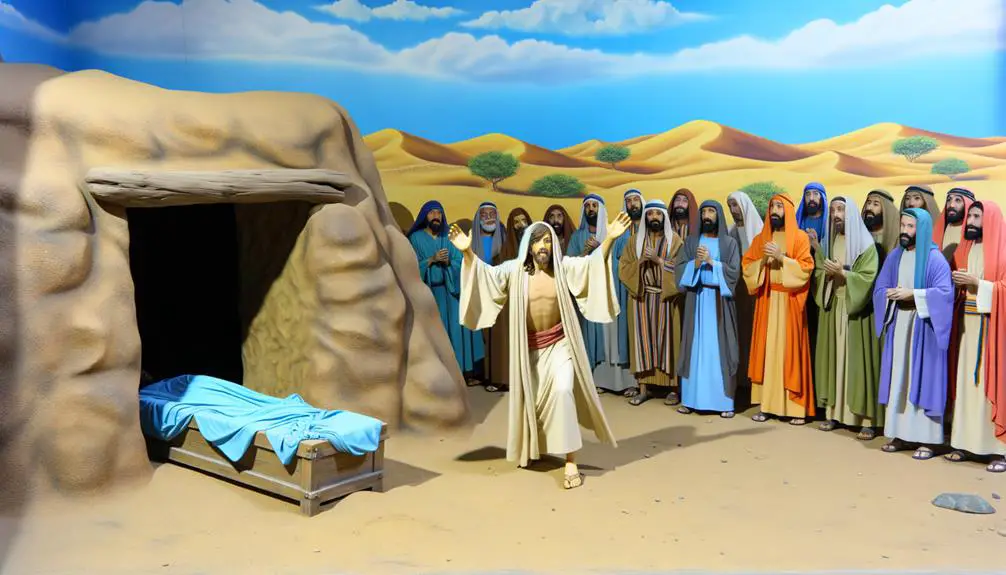
In John's Gospel, Lazarus' return from the dead stands as a pivotal event, showcasing Jesus' power over life and death with profound theological implications. This occurrence isn't merely a miracle; it's a deeply symbolic act, rich in meaning and insight into the nature of faith, the power of Jesus, and the promise of eternal life. Martha's faith, despite her brother's death, underscores a crucial aspect of this story. She believes in Jesus' power, yet her understanding of resurrection is initially limited to the end times. Jesus' response to her, declaring Himself the resurrection and the life, expands the concept of resurrection from a future event to an immediate, accessible reality through Him.
The tomb's significance can't be overstated. It represents not just Lazarus' physical death but also the spiritual death from which Jesus promises to deliver. The act of calling Lazarus out of the tomb and back to life illustrates Jesus' authority over death, prefiguring His own resurrection and offering a foretaste of the general resurrection to come.
Consider these key elements:
- Martha's faith reveals an evolving understanding of Jesus' identity and power.
- The tomb's significance extends beyond a place of death to a site of miraculous rebirth.
- Jesus' command for Lazarus to come out demonstrates His authority over death.
- The event reinforces the promise of resurrection for all who believe in Him.
Lazarus' return from the dead isn't just a miracle but a profound theological statement, demonstrating Jesus' mastery over death and previewing the resurrection hope offered to all believers.
Jesus' Resurrection

Central to Christian faith, Jesus' resurrection marks a pivotal moment in history, demonstrating His divine authority over death and providing a foundation for the belief in eternal life. This event not only fulfills numerous Old Testament prophecies but also embodies the essence of Easter significance, celebrating victory over sin and death.
Analyzing Jesus' resurrection, you'll find it intricately linked to resurrection prophecies. Isaiah 53:11, for instance, foretells the suffering servant's knowledge of satisfaction through His anguish, hinting at resurrection. Psalms 16:10, with its promise that God will not abandon His Holy One to the realm of the dead, further cements this prophecy. These prophecies, among others, underscore the resurrection's foretold nature and its critical role in validating Jesus' messianic claims.
Prophecy Reference |
Fulfillment Event |
|---|---|
Isaiah 53:11 |
Jesus' resurrection offers the knowledge of righteousness to many. |
Psalm 16:10 |
Jesus is not abandoned to the grave; God raises Him from death. |
Hosea 6:2 |
After two days, He revives us; on the third day, He raises us up. |
Jonah 1:17 |
As Jonah was three days in the belly of a great fish, so was Jesus in the heart of the earth. |
Zechariah 12:10 |
They will look on Him whom they have pierced, recognizing Jesus' sacrifice and resurrection. |
Through this lens, Jesus' resurrection isn't just a historical or religious event; it's a fulfillment of a meticulously laid out divine plan, showcasing the coherence and depth of biblical prophecy and its realization.
The Saints of Jerusalem
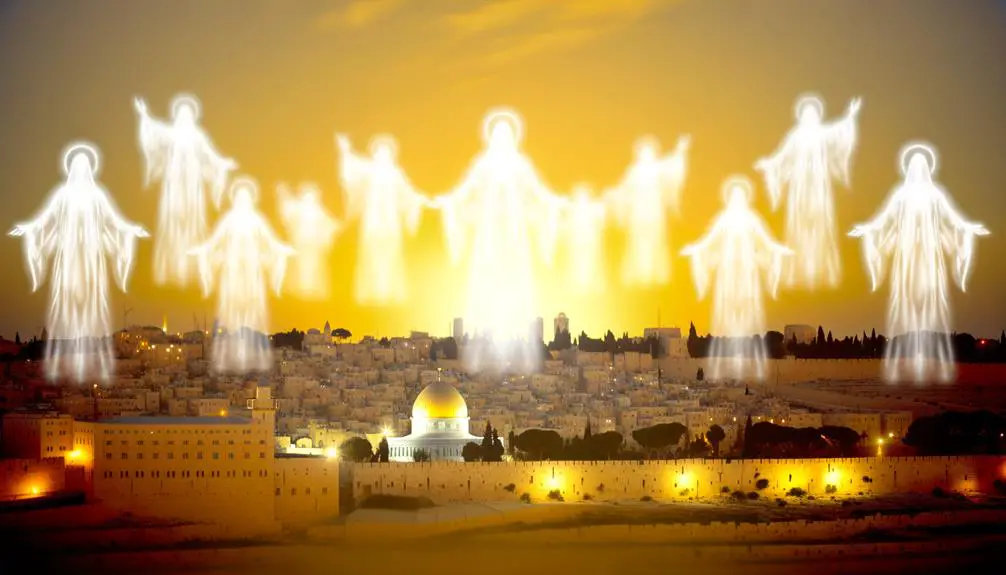
Reflecting on Jesus' resurrection leads us directly to another significant biblical account of the dead being brought back to life, known as the resurrection of the saints of Jerusalem. This event, described briefly in the Gospels, provides a profound moment of awe and wonder within the New Testament narrative. Here's a closer look at its historical context and theological significance:
- Historical Context: This event occurs immediately following Jesus' crucifixion. The Gospel of Matthew specifically mentions the tombs breaking open and the bodies of many holy people who'd died being raised to life. They came out of the tombs after Jesus' resurrection and went into the holy city, appearing to many. This description situates the event firmly within the tumultuous period of Jesus' death and resurrection, emphasizing its miraculous nature.
- Theological Significance: This resurrection serves multiple purposes within Christian theology. Firstly, it acts as a precursor to Jesus' own resurrection, highlighting his power over death. Secondly, it signifies the inauguration of the new covenant, where death is conquered not just for Jesus but for all who believe in him.
- Eyewitness Testimony: The account suggests that these resurrected saints were seen by many in Jerusalem, providing a form of eyewitness testimony to the miraculous events surrounding Jesus' death and resurrection.
- Symbolic Representation: Lastly, this event symbolizes the breaking of the barrier between life and death. It offers a glimpse of the future resurrection promised to all believers, underlining the hope and eternal life found in Jesus.
Through this lens, the resurrection of the saints of Jerusalem stands as a compelling testament to the power of God and the promise of resurrection for all believers.
Tabitha's Revival
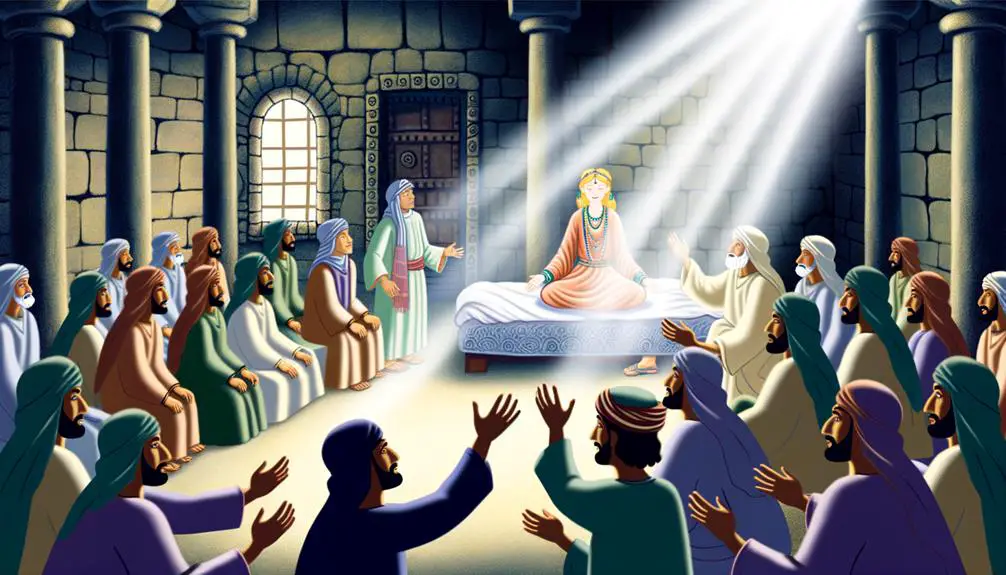
Tabitha's revival, chronicled in the Acts of the Apostles, exemplifies the early Christian community's experience with divine intervention and miraculous occurrences. Known also as Dorcas, her story is not just a testament to the power of faith but highlights the early church's emphasis on charity and community support. Tabitha was celebrated for her acts of kindness and charity, particularly towards the widows of Joppa. Her death left a void in the community, prompting the disciples to seek Peter's intervention.
Upon his arrival, Peter was greeted with the tangible manifestations of Dorcas' charity; the widows displayed the garments she had made. This moment underscores the intersection between faith and works, a recurrent theme in Christian theology. Peter's prayer and subsequent command for Tabitha to rise were not just acts of faith but were deeply embedded in the communal ethos of early Christianity, where miracles served as both spiritual and social catalysts.
Aspect |
Significance |
|---|---|
Dorcas' Charity |
Embodied the Christian call to service, illustrating how individual acts of kindness weave the fabric of the community. |
Peter's Prayer |
Reflects the apostolic authority and the power of prayer, emphasizing faith's role in invoking divine intervention. |
Tabitha's revival isn't merely a narrative about coming back to life; it's an exploration into how early Christians perceived the interplay between divine power and human agency. Her resurrection by Peter, catalyzed through prayer, signifies the potential of faith to transcend death, reinforcing the nascent church's belief in the power of the divine and the importance of communal bonds and acts of charity.
Frequently Asked Questions
How Do the Resurrections in the Bible Reflect the Cultural and Religious Beliefs of the Time Period in Which They Were Written?
The resurrections depicted in the Bible mirror the cultural adaptation and sociopolitical context of their times. These narratives showcase how beliefs about life, death, and the hereafter were intertwined with the evolving religious and cultural landscapes.
They offer insights into how communities sought to understand and explain the mysteries of existence, reflecting broader societal values and concerns. Through these stories, you can trace the shifts in theological and philosophical thought across ages.
Are There Any Instances of Resurrection in the Bible That Are Interpreted Differently by Various Christian Denominations?
Yes, various Christian denominations interpret instances of resurrection in the Bible differently, sparking both denominational interpretations and ecumenical dialogues. This divergence stems from theological nuances and scriptural emphases that vary across denominations.
For example, the resurrection of Lazarus might be seen not just as a miracle but as a sign of spiritual awakening in some traditions. Such interpretations highlight the rich tapestry of belief within Christianity, underscoring the diversity and depth of scriptural understanding.
How Have the Stories of Resurrections in the Bible Influenced Modern Literature and Media?
You've likely noticed how modern literature and media frequently draw from biblical resurrection stories, using them as narrative inspiration. These tales offer complex themes of rebirth, sacrifice, and redemption, making them ripe for modern adaptations.
They serve not just as plot devices but as deep wells of symbolic meaning, influencing genres from fantasy to science fiction. This trend underscores the enduring impact of these ancient narratives on contemporary storytelling and thematic exploration.
In What Ways Do the Resurrections in the Bible Serve as Metaphors or Symbols for Themes Beyond Literal Death and Revival?
You'll find that in the Bible, resurrections aren't just about coming back to life; they're packed with rebirth symbolism and transformative experiences. These stories serve as profound metaphors for personal and communal renewal, emphasizing the possibility of change and new beginnings.
They delve into themes of redemption, hope, and the eternal cycle of death and rebirth, offering a rich tapestry for analysis beyond their literal narrative context.
What Are the Theological Implications of Resurrection for Contemporary Christian Faith and Practice, Beyond the Specific Instances Listed?
Considering the theological implications of resurrection, you'll find it central to Christian faith, offering eternal hope and underpinning spiritual transformation. This concept doesn't just recount past miracles; it actively shapes believers' lives today, encouraging a pursuit of righteousness and a profound sense of renewal.
Beyond historical events, it symbolizes a pathway to overcoming spiritual death, emphasizing the transformative power of faith and the promise of eternal life with God.
Conclusion
In the tapestry of biblical narratives, the themes of life, death, and resurrection intertwine, much like the cycle of seasons—each story offering a distinct hue of hope against the backdrop of despair.
From the widow's son to Jesus' monumental return, these resurrections serve as pivotal points, not just in scripture, but in the broader discourse on faith and the afterlife.
Analyzing these accounts reveals a nuanced understanding of divine intervention, mortality, and the everlasting quest for eternal life.



Sign up